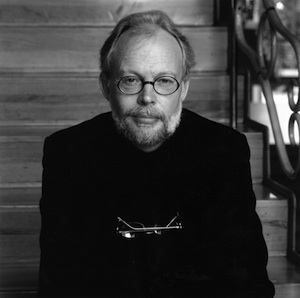 Poul Ruders
Poul Ruders
Abysm
Canadian premiere: Feb. 24, 2008 Victoria
US premiere: Mar. 5, 2008 New York City
KafKapriccio
Canadian premiere: Oct. 17, 2010 Victoria
US premiere: June 6, 2011 New York City
Poul Ruders was born in Ringsted, Denmark on March 27, 1949. His early studies in piano and organ led eventually to studies in orchestration with the Danish composer Karl Aage Rasmussen. Ruders’ first compositions date from the mid-60s.
Ruders regards his own compositional development as a gradual one, with his true voice emerging in the chamber concerto, Four Compositions (1980). Writing about Ruders, the English critic Stephen Johnson states: “He can be gloriously, explosively extrovert one minute – withdrawn, haunted, intently inward-looking the next. Super-abundant high spirits alternate with pained, almost expressionistic lyricism; simplicity and directness with astringent irony.”
Poul Ruders has created a large body of music ranging from opera and orchestral works through chamber, vocal and solo music. In recent years, performances of his work on both sides of the Atlantic and in such distant locals as China, Japan and Russia have taken place with increasing regularity. With the overwhelming success of his second opera, The Handmaid’s Tale (1996-98) produced in Copenhagen (2000), Ruders became even more in demand, with commissions coming in rapid succession from the Berlin Philharmonic, New York Philharmonic, BBC Symphony Orchestra and the Royal Danish Opera. Recent performances include productions of The Handmaid’s Tale in Toronto and London, and orchestral premieres and performances in Berlin, New York and London.
Kafkapriccio (2007-08) is a distillation for fourteen instruments from the massive forces of Ruders’ 2005 opera Kafka’s Trial. This opera, premiered in 2005 at the Royal Danish Opera explores Kafka’s unfinished masterpiece (including dramatized events from the writer’s life).
“The five movements paraphrase the tunes, harmony, rhythm and see-sawing mood swings of the original music, and needless to say, when you whittle the complex activity of 90-odd musicians plus 11 soloists and chorus down to only a handful of solo players, the end result comes out significantly different and far more transparent than the broadly speckled canvas of the operatic score.
In the libretto by Paul Bentley, two plots run parallel throughout the opera: Franz Kafka’s private struggle – in particular with one woman, Felice Baur, whom he cannot make up his mind to marry (or not marry), and the fictitious story of the hapless Josef K. the victimized (and rather obnoxious) protagonist of Kafka’s famous, unfinished novel The Trial.
It was obvious to me, when deciding what to do with a miniaturized version of the opera, that I had to focus on the actual personae dramatis in this “double story”. Franz Kafka was hugely interested in klezmer, the folkloristic music of the Jewish communities in Eastern Europe around the beginning of the 20th century. For this reason, KAFKA, the first movement, is a breathtakingly fast, klezmer-inspired opening, depicting the tortured soul of that most mythologized of authors.
In the second movement, FELICE, I dim the light, so to speak, composing a tranquil music mirroring the thoughts and sorrows of a woman being held hostage, emotionally, by a man who cannot make up his mind.
In the third movement, LENI, we are all of a sudden thrown head first into the middle of the novel proper. The main character, Josef K, has been arrested and accused of a crime that he, and nobody else, seems to know what is. Accompanied by his Uncle Albert, Josef seeks out a dodgy (and mortally ill) lawyer, Dr. Huld, for legal assistance. Dr. Huld employs an uncommonly lascivious and sluttish female factotum, Leni, who succeeds in seducing Josef. The music should leave none in doubt as to the success of her endeavour…
Josef K. works as a clerk in a bank. After being arrested, he is allowed to go to work and carry on as usual, but the dreary daily routine at the bank has changed. The term surreal does not even begin to describe it. In a broom closet, Josef finds the two warders who arrested him – they are being flogged by a mysterious official (the flogger), because they helped themselves to Josef’s breakfast during the arrest. The fourth movement, JOSEF, juggles the music from these relevant scenes in the opera.
These who have read The Trial will remember that in the last chapter, Josef K. is being executed in a stone quarry by two sinister characters wearing bowler hats. Even at this stage of the story, Josef does not know why all this happens, but nevertheless he is finally convinced that he actually deserves to die. Which he does – depicted in the music for the fifth and last movement – THE EXECUTION.” – Poul Ruders
“Abysm derives its title from the literary quotation heading the first of the 3 movements of the entire work. Not uncommonly writers put a motto – often a short quotation from famous literary pieces … on the page preceding their own work, as an “appetizer” of sorts or a spiritual and mental companion to what the reader is about to experience. Each of the 3 movements is inspired by a short literary quotation taken out of its original context, serving solely as a spiritual inspiration for the music that follows; in other words, it is the beauty and profundity of the words and the many-layered associations yielded by them, which are mirrored in the music.”
The 3 tone-poems – or tone-chapters, rather, are:
1) ABYSM
“…What seest thou else/In the dark backward and abysm of time?”(W. Shakespeare “The Tempest”)
2) BURNING
“…put your face on the burning sand and on the earth of the road, since all those who are wounded by love must have the imprint on their face, and the scar must be seen”(“The Conference of the Birds” by Farid Ud-din Altar)
3) SPECTRE
“…The Spectre Rose in Pain/A Shadow blue obscure & dismal.”(W. Blake “Vala or the Four Zoas”)
– Poul Ruders
